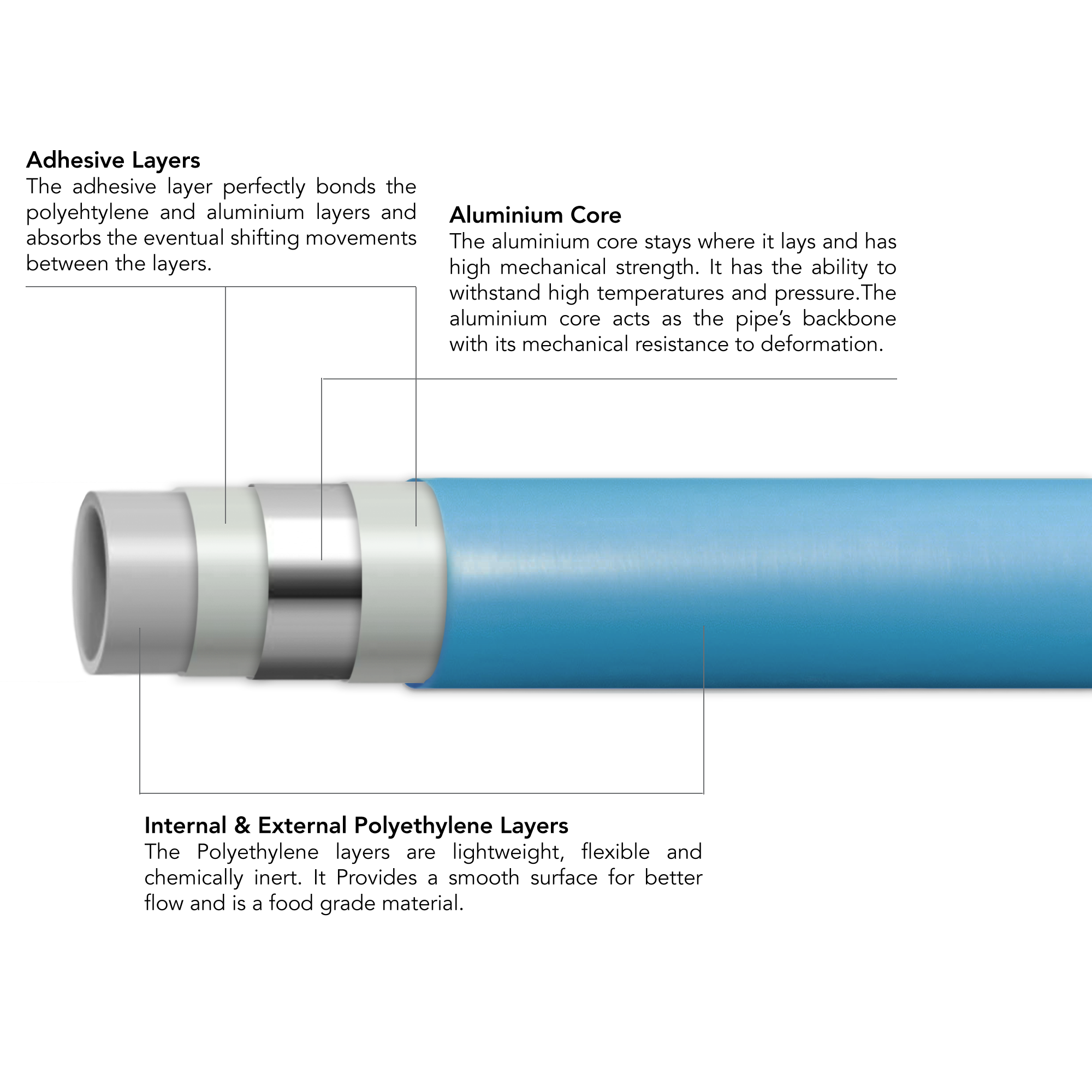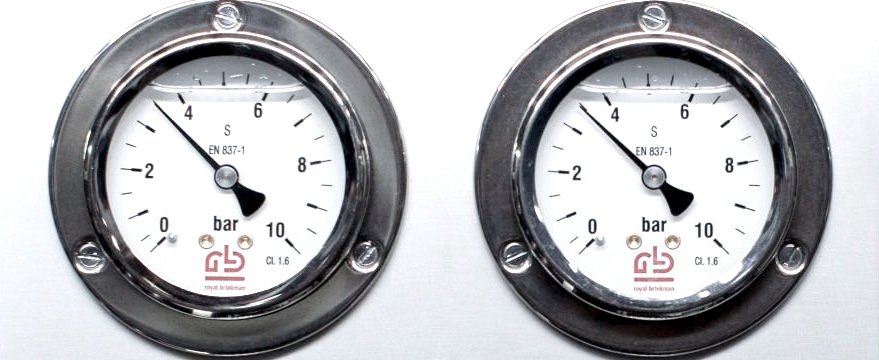
PE-AL-PE Pipes for Compressed Air Supply
Jindal Air Connect specialises in solutions for compressed air and fluids distribution and provides superior performing compressed air and gas systems with engineered longevity to reduce operating costs and improve productivity. The aluminum layer allows Jindal MLC pipes to withstand high working pressure and prevent air from permeating into the pipe. They are easily bent, which makes the use of numerous fittings unnecessary. Jindal MLC pipes are safe and reliable choice for compressed air supply.
-
Compressed Air is required in manufacturing and industrial activities for a multitude of applications. It is used to control and regulate appliances and is the driving force for pneumatic drills, conveyors, spray guns, machine tools etc. For these appliances to function. correctly it is very important to ensure that the quality of air employed is excellent. In Air Connect pipes the inner surface of the pipe which comes in direct contact with air is made of polyethylene which unlike metal pipes guarantees absence of rust and impurities formed by condensation that could become detached from the pipe walls. Clean Air also means that the filters require less maintenance. Also Air Connect pipes are suitable for use at high operating pressures of upto 232 psi. Air Connect Pipes are bendable without springing back and come in coils of upto 200 meters which significantly reduces the number of joints in the piping system and improves air flow. Air Connect, the NEXT-Generation pipe system is manufactured with the latest german technology at our state of the art facility in Dehradun, Uttarakhand, India. The performance is more reliable and designed for tropical conduction with very good sealing ensuring Zero leakage.
TECHNICAL SPECIFICATIONS
-
232 Psi at 23°C
175 Psi at 60°C
-
-20°C to 60°C
-
0.45 W/m.k
-
25 x 10^-6 m/m.k
-
870 Psi - 507.5 Psi
-
391.5 Psi - 290 Psi
PIPINg system design
-
Locate each process, work station, or piece of equipment that uses compressed air. They should be located on a plan, and a complete list should be made to simplify record keeping. This initial process will act as a beginning for your piping layout.
-
Determine the volume of air and pressure range required at each location. Information regarding pressure and flow rates of the equipment such as tools can be obtained from the manufacturer. If the pressure and flow rates are not known, assign some preliminary rates until the specific values can be obtained.
-
Determine the system conditioning requirements for each piece of equipment. This includes the allowable moisture content, particulate size, and oil content. The system may require conditioning equipment including dryers, filters, lubricators and pressure regulators.
-
Establish how much time the individual tool or process will be in actual use for a one-minute period of time. This is referred to as the 'duty cycle'. In most industrial applications, tools or operations of a similar nature are usually grouped together.
-
Establish the maximum number of locations that may be used simultaneously on each main, and for the project as a whole. This is known as the 'use factor'.
-
Establish the extent of allowable leakage. Leakage is a result of the number and type of connections, the use of disconnects, the age of the system and the quality of the initial assembly process. Many small tools and operations will result in more leakage then fewer larger applications. A well maintained compressed air system will have an allowable leakage rate of 2-5%.
Note: This allowable leakage rate applies only to compressed air made on site. All other inert gas systems must be designed with the strictest health and safety considerations in mind including preventing leakage of any pipe contents.
-
Establish any allowance for future expansion.Thought should be given to over sizing some components (i.e., main supply lines) to avoid the cost of replacement at a later date.
-
Select the air compressor layout and assign a preliminary pressure drop for the system.
-
Select the air compressor type, conditioning equipment, equipment location, and air inlet, making sure that scfm (L/min) is used consistently for both the system and compressor capacity rating.
EZ-Fit compression fittings
It is essential that all Jindal MLC Pipes are installed using EZ Fit compression fittings. EZ Fittings combine the positive feature of high reliability wiht a simple installation technique that does not require any special tools. Click to learn more
installation GUIDE
Learn the proper way to install Jindal MLC Pipes by watching a quick video linked below. When installed correctly there is zero chance of leakages and you will have a piping system that will last you over 50 years.
At Jindal MLC Pipes we regularly subject our products to inspection and long-term testing. Our in house Laboratory keeps material specifications and long-term properties under constant scrutiny. This provides the necessary foundation for product enhancements performed within our Research & Development department.
As a result you will always be supplied with the highest possible quality and latest technology in the plumbing and piping system. Our range of plastic fittings is specifically designed for Indian plumbing techniques.
RAW MATERIALS
At Jindal MLC Pipes we use the highest quality raw material available on the market, importing from countries like Belgium & Israel.
-
Polyethylene or PE is a polymer consisting of long chains of the monomer ethylene. It is created through the polymerization of ethene and is classified into different types based on Density. High density polyethylene or HDPE is used to manufacture Jindal MLC Pipes. It has a low degree of branching and thus stronger inter-molecular forces and tensile strength.
-
Aluminium is a soft, lightweight, non-toxic and malleable metal with appearance ranging from silvery to dull gray depending on surface roughness. Aluminium alloys have yield strengths ranging from 200mpa to 600mpa. For Jindal MLC Pipes, a specialised grade of ALuminium is used which is manufactured specifically for these pipes and have the right balance of strength and flexibility as required for bending applications.
-
Nylon is one of the most widely used plastics because of its extreme strength, wear resistance and self lubricating properties. Nylons are also known to have high impact resistance, high operating temperature and are light weight. Nylon is commonly used as a replacement for bronze, brass, aluminium, steel and other metals. The glass reinforcement gives the material higher compressive strength and rigidity, as well as imporved frictional characteristics.













